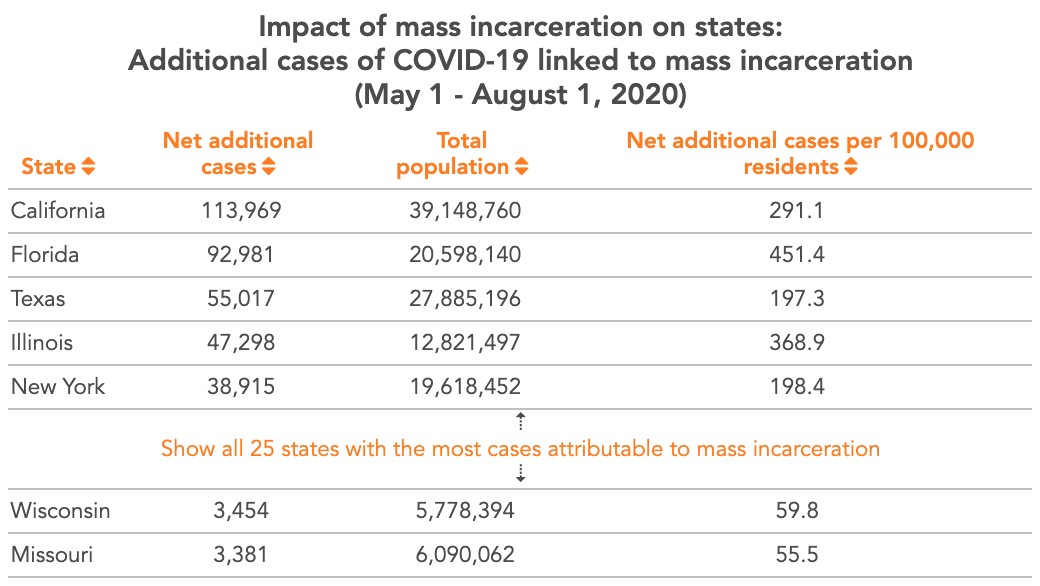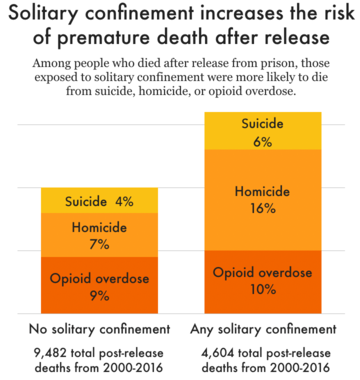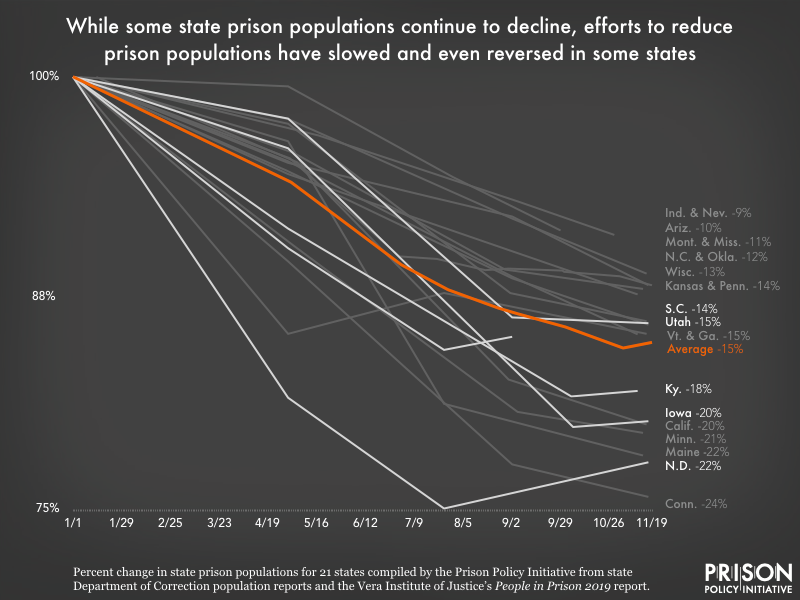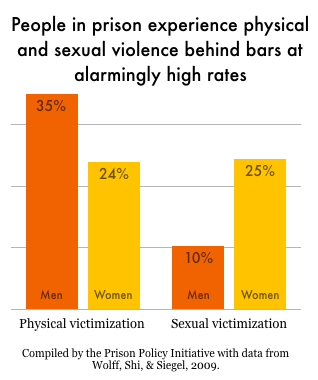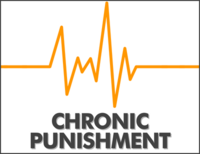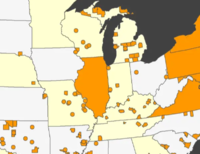| Alabama |
Phase 2 |
Phase 2 states: “ADPH will plan for the critical populations to include homeless, incarcerated, and uninsured persons.” |
Maybe Phase 1B |
Corrections staff are not specifically mentioned. Does use the CDC Phased Approach chart, which includes “Other essential workers” in Phase 1-B. Elsewhere, the report refers to CISA guideance on who falls into that category, which incudes corrections. |
State Plan |
|
| Alaska |
No |
Incarcerated people are not specifically mentioned. Phase 2 does say: “During this phase the Team will introduce outreach to critical populations and the general public who are able to receive the vaccine.” |
No |
Corrections staff are not specifically mentioned. Does state that during Phase 1B, “additional essential workers who have not received the vaccine in Phase 1A may be able to receive it.” |
State Plan |
|
| Arizona |
Phase 2 |
“People who are in correctional facilities/incarcerated” are listed in Phase 2. |
Maybe Phase 1B |
Corrections staff are not specifically mentioned, although “protective service occupations” do fall under Phase 1B. The report does use the CDC Phased Approach chart, which places “other essential workers” in Phase 1B. And it refers to CISA guideance on who may be considered essential workers, which incudes corrections. It also refers to the governor’s executive order outlining essential services, which also includes corrections. |
State Plan |
|
| Arkansas |
No |
“Residents of long-term care facilities and other congregate-living facilities” are listed in phase 2. However, since correctional staff are mentioned specifically, we cannot assume this includes incarcerated people. |
Phase 1B |
Phase 1B includes “Employees of state correctional facilities” (subsection: “essential workers at increased risk”). |
State Plan |
|
| California |
Probably Phase 1 or 2 |
In the phase 1 discussion: “Depending on prioritization guidelines, this phase may also include people in correctional facilities or other congregate living facilities.” This specific mention leads us to believe that if incarcerated populations are not ultimately included in Phase 1, they will be included in Phase 2, which will be used to “ensure vaccine access to all members of Phase 1 critical populations who were not yet vaccinated and also expand our communication efforts to broaden vaccination access to other groups of essential workers and groups at increased risk of COVID-19.” |
Probably Phase 1B |
Phase 1 includes “critical infrastructure workforce.” Elsewhere, the report says that critical infrastructure is based on guideance from the CISA list of critical occupations (which includes corrections). In addition, the report mentions that workforce data has been collected on corrections, and specifies that non-healthcare essential workers will fall in Phase 1-B. |
State Plan |
|
| Colorado |
No |
In the original plan, Phase 2A included “incarcerated adults.” However, Colorado later released updated guidelines. The new guidelines have fewer subcategories, and people living in congregate living spaces — including incarcerated people — are no longer specifically mentioned in any phase. This, combined with the fact that Gov. Jared Polis has verbally walked back the earlier placement of incarcerated people in Phase 2A, suggests that incarcerated people are no longer assigned to a specific phase. |
Phase 2 |
In the original plan, “correctional workers” were included in Phase 1B. However, Colorado later released updated guidelines, which have fewer specifics and fewer subcategories. Corrections workers are no longer mentioned specifically, but they should fall under “Workers serving people that live in high-density settings,” who are now listed in Phase 2. |
State Plan |
Updated State Vaccine Information |
| Connecticut |
Phase 1B |
In the original plan, incarcerated people were not specifically mentioned. After the release of the plan, Gov. Ned Lamont indicated that incarcerated people and staff in state prisons — as well as people in other congregate settings — belong to Phase 1B. |
Phase 1B |
The original plan was unclear on where corrections staff would belong, but seemed to suggest they would be in Phase 1B. After the release of the plan, Gov. Ned Lamont indicated that incarcerated people and staff in state prisons — as well as people in other congregate settings — belong to Phase 1B. |
State Plan |
ACLU of Connecticut Press Release |
| Delaware |
Phase 1 (Tier 1C) |
Phase 1 (Tier 1C) includes “Congregate care (Examples include- prison workers and inmates…).” |
Phase 1 (Tier 1C) |
Phase 1 (Tier 1C) includes “Congregate care (Examples include- prison workers and inmates…).” |
State Plan |
|
| Florida |
No |
|
No |
Corrections staff are not specifically mentioned. The report does say that, “During Phase 1, PODs may be designed to vaccinate first responders, law enforcement officers and essential employees.” It also says the CISA essential worker guidelines will be used in the development of vaccine strategies, but unlike some states, does not suggest that all essential workers will neccessarily be assigned to an early phase. |
State Plan |
|
| Georgia |
Phase 2 |
Phase 2 includes “Staff and individuals in jails, prisons, detention centers.” |
Phase 2 |
Phase 2 includes “Staff and individuals in jails, prisons, detention centers.” |
State Plan |
| Hawaii |
Stage 2 of 4 |
Stage 2 includes “People in prisons, jails, detention centers, and similar facilities, and staff who work in such settings.” |
Stage 2 of 4 |
Stage 2 includes “People in prisons, jails, detention centers, and similar facilities, and staff who work in such settings.” |
State Plan |
|
| Idaho |
Phase 2 |
“Correctional Facilities” are listed as a “Phase 2 organization type.” It also uses the CDC Phased Approach chart, which lists “critical populations” in Phase 2. Elsewhere, a list of critical populations includes “People who are incarcerated/detained in correctional facilities.” |
Probably Phase 1B |
Uses the CDC Phased Approach chart, which lists “other essential workers” in Phase 1-B. Elsewhere in the report, a list of “other essential workers” (and estimated counts) includes “Staff of correctional or detention facilities.” This specifically includes employees belonging to both the Idaho Department of Corrections and the Idaho Sheriff’s Association. |
State Plan |
|
| Illinois |
Phase 1B |
In the original plan, incarcerated people were included within “critical populations” in Phase 2. In an updated plan from December 31, “sheltered population, homeless/day programs, and inmates” are included within Phase 1B. |
Phase 1B |
In the original plan, corrections staff were not specifically mentioned, but it seemed like they might be included in Phase 1B. In an updated plan from December 31, correctional officers are specifically listed under “frontline essential workers” in Phase 1B. |
State Plan |
Updated State Vaccine Information |
| Indiana |
Phase 2 |
Phase 2 includes “persons living in correctional facilities.” |
Phase 2 |
Phase 2 includes “Corrections, other critical infrastructure workers, other congregate settings.” |
State Plan |
|
| Iowa |
Phase 2 |
“Local public health agencies are preparing for the following types of vaccination clinics in Phase 2: … Corrections (jails, prisons or other transitional correctional facilities)” |
Maybe Phase 1 |
Phase 1 includes “Non-healthcare worker critical workforce such as agriculture and food processing as well as other key critical infrastructure,” but does not mention corrections specifically. The report links to CISA guideance on who falls into that category, which incudes corrections. |
State Plan |
|
| Kansas |
Phase 2 |
In the original plan, Kansas mentioned “individuals living in congregate settings” as a critical population, but did not mention incarcerated people specifically. However, a later update specifically names correctional facilities as part of Phase 2, under “those living or working in licensed congregate settings and other special care or congregate environments where social distancing is not possible.” |
Phase 2 |
Corrections staff were not specifically mentioned in the original plan. However, a later update specifically names correctional facilities as part of Phase 2, under “those living or working in licensed congregate settings and other special care or congregate environments where social distancing is not possible.” |
State Plan |
Updated State Vaccine Information |
| Kentucky |
Either Phase 1B or Phase 2 |
Unclear. Two different attachments list incarcerated people in two different phases.
“Correctional Facility Residents” are listed in Phase 1B, as a “vulnerable population” in Attachment 4: Projected Vaccination Target Groups. (Rationale: “People who would prevent the risk of spread if vaccinated.”)
But elsewhere in the report (Attachment 3: Framework for Equitable Allocation of COVID-19 Vaccine), “Incarcerated/detained people and staff” are listed as part of Phase 2. This chart notes that this combined population has a High Risk of Acquiring Infection, Medium Risk of Severe Morbidity and Mortality, Low Risk of Negative Societal Impact, and High Risk of Transmitting Infection to Others. “Mitigating Factors for Consideration” says: “Adequate access to personal protective equipment. Effective institutional/workplace management of exposure.” |
Either Phase 1B or Phase 2 |
Unclear. Two different attachments list corrections staff in two different phases.
“Corrections Facilities workers” are listed in Phase 1B, as part of “critical infrastructure in Attachment 4: Projected Vaccination Target Groups. (Rationale: “Essential to public order and safety; Working conditions give them elevated risk of infection; close contact with people at very high risk of poor outcomes.”)
But elsewhere in the report (Attachment 3: Framework for Equitable Allocation of COVID-19 Vaccine), “Incarcerated/detained people and staff” are listed as part of Phase 2. This chart notes that this combined population has a High Risk of Acquiring Infection, Medium Risk of Severe Morbidity and Mortality, Low Risk of Negative Societal Impact, and High Risk of Transmitting Infection to Others. “Mitigating Factors for Consideration” says: “Adequate access to personal protective equipment. Effective institutional/workplace management of exposure.” |
State Plan |
|
| Louisiana |
Phase 2 |
Phase 2 includes “all incarcerated adults in Louisiana.” |
Phase 1B |
Phase 1B includes “Corrections Officers and Jailers.” This is further defined as “Includes state corrections officers, as well as parish and local jailers with direct exposure to the inmate/prisoner population.”
The report gives the following Justification: “Corrections officers and jailers are eligible for early vaccination for reasons similar to Congregate Care Facility personnel. They perform a job that is essential for continued societal function and care for a group of citizens who are in close quarters in a congregate setting. While not typically as at risk as their elderly counterparts in Congregate Care Facilities, many prisoners have underlying diseases that put them at increased risk as well. Similar to the rationale for distribution of limited vaccine in the Congregate Care Facility personnel, assuming inadequate supply for all personnel who fall in this category, prioritization based on community positivity rate is recommended, since the goal is to prevent personnel bringing the disease into the facility.” |
State Plan |
|
| Maine |
Probably Phase 2 |
In the original plan, Phase 2 includes “People in prisons, jails, detention centers, and similar facilities, and staff who work in such settings.” However, in a January 13 briefing, Gov. Janet Mills possibly walked this back, noting: “We think it’s first and foremost important to vaccinate the staff. Inmates will come later at a later time, undetermined.” She also noted that incarcerated people who meet the state’s Phase 1B requirements (those 70+ or with underlying health conditions) are “not excluded, they’re not specifically included” within Phase 1B. |
Phase 1B |
In the original plan, Phase 2 included “People in prisons, jails, detention centers, and similar facilities, and staff who work in such settings.” A December 29 update answering “frequently asked questions” specifically lists corrections officers as “frontline essential workers” in Phase 1B. |
State Plan |
Updated State Vaccine Information;
Governor’s Jan 13 briefing |
| Maryland |
Phase 1 |
Phase 1 includes “People in Prisons, Jails, Detention Centers and Staff” and the subgroup “Incarcerated/Detained Individuals.” |
Phase 1 |
Phase 1 includes “People in Prisons, Jails, Detention Centers and Staff” and the subgroup “Correctional Officers, Jailers, Support Staff.” |
State Plan |
|
| Massachusetts |
Phase 1 |
In the original plan, incarcerated people were not specifically mentioned. Later, on December 9, Massachusetts issued an update that includes “congregate care settings (including corrections and shelters)” in Phase 1. |
Phase 1 |
In the original plan, corrections staff were not specifically mentioned. Later, on December 9, Massachusetts issued an update that includes “congregate care settings (including corrections and shelters)” in Phase 1. The Baker administration indicated this would include staff as well as incarcerated people. |
State Plan |
Updated State Vaccine Information |
| Michigan |
No |
“High risk populations, and other critical populations” are listed in Phase 2, but incarcerated populations are not specifically included. |
No |
Corrections staff are not specifically mentioned. “Populations considered essential personnel” are listed in Phase 2. It further says: “Different categories of essential personnel have been identified and we continue to add to the list with additional critical infrastructure workers.” However, this list is not attached. |
State Plan |
|
| Mississippi |
Phase 2 |
Phase 2 includes “Inmates and Staff” in “Prison and Jails.” |
Phase 2 |
Phase 2 includes “Inmates and Staff” in “Prison and Jails.” |
State Plan |
|
| Missouri |
Probably Phase 3 |
“People living and working in congregate settings” are included in Phase 2. However, incarcerated populations are not specifically mentioned. And the state does not seem to expect to complete vaccination of incarcerated populations in Phase 2. Phase 3 discussion says: “Local public health authorities and the state health authority will target vaccination efforts toward the most vulnerable populations, such as… local incarcerated individuals…” This appears to mean that Missouri will give special attention to vaccinating incarcerated populations during Phase 3, which is also when the general population will be vaccinated. |
Phase 1B |
“Phase 1B includes “First Responders (Examples: non-hospital EMS, Law Enforcement Officers, Fire and Correction personnel).” It includes the following rationale: “Personnel within this category provide essential emergency services that mostly cannot be performed virtually. As a result of these duties, they have unavoidable potential exposures that threaten both their well-being and the community they cannot serve during illness. Accelerated economic recovery and the provision of essential government services require the performance of these duties.
Additionally, inmates’ confined nature has been amenable to procedural controls to reduce the likelihood of correctional facility outbreaks. As a result, staff now represent the most likely source of a facility outbreak. Vaccination of corrections staff can vastly reduce this source of potential attacks.” |
State Plan |
|
| Montana |
Tier 3 of 5 |
“The report outlines five “tiers.” “People at increased risk of acquiring or transmitting Covid-19” belong to Tier 3. Elsewhere in the report, a list of “people at increased risk of aquiring and transmitting Covid-19” includes “People who are incarcerated/detained in correctional facilities.” |
Maybe Tier 1 of 5 |
Corrections staff are not specifically mentioned. Of the five tiers, Tier 1 includes “Critical infrastructure workforce,” which cites CISA guideance on who falls into that category, which includes corrections. However, the report specifies that if there is extremely short supply of the vaccine, law enforcement fall at the bottom of Tier 1. |
State Plan |
|
| Nebraska |
Phase 1B |
Phase 1-B includes “Incarcerated populations” (under “Vulnerable and Congregate populations”). |
Phase 1B |
Phase 1-B includes “Correctional Staff” (under category “Essential Critical Infrastructure workforce”). |
State Plan |
|
| Nevada |
Tier 2 of 4 |
In the original plan, “NDOC Inmates” were listed as #2 of 8 in “Tier 3: People at Increased Risk for Severe Illness or of Acquiring/Transmitting COVID-19.” However, an updated plan placed “NDOC Inmates” at the very bottom of “Tier 2: Critical Infrastructure Workforce by Priority Order” (incarcerated people are #15 of 15 in that tier). |
Tier 1 of 4 |
In the original plan, “Nevada Department of Corrections Staff” are listed specifically in Tier 1 of 4. (The plan does note, however, that Tier 1 will be vaccinated in priority order, as supply allows, and corrections staff are #9 of 10 on the priority order.) An updated plan issued later keeps NDOC staff in Tier 1: “Nevada Department of Corrections (NDOC) staff will be invited to closed vaccination events within their community and are included in Tier 1.” |
State Plan |
Updated State Vaccine Information |
| New Hampshire |
Phase 2 |
Uses the National Academy of Medicine recommendations, which list “people in prisons, jails, detention centers, and similar facilities, and staff who work in such settings” in Phase 2. |
Phase 2 |
Uses the National Academy of Medicine recommendations, which list “people in prisons, jails, detention centers, and similar facilities, and staff who work in such settings” in Phase 2. |
State Plan |
|
| New Jersey |
Probably Phase 2 |
“New Jersey intends to follow the CDC Phased Approach framework.” This framework includes “critical populations” in Phase 2. Elsewhere in the report, “Adults detained in correctional facilities or county jails” are included as a “critical population” under “Adults at higher risk for severe COVID-19 due to congregate living and/or working environments.” |
Probably 1B |
The report states that “New Jersey intends to follow the CDC Phased Approach framework.” This framework includes “other essential workers” in Phase 1-B, which further includes: “People who play a key role in keeping essential functions of society running and cannot socially distance in the workplace (e.g., emergency and law enforcement personnel not included in Phase 1-A…).” Elsewhere, the report cites CISA guideance on essential workers, which includes corrections. The report indicates that many of these essential workers will in fact be included in Phase 1B, when it estimates the number of “other essential workers,” including those in “Food & agriculture, transportation, education, energy, water, law enforcement, government, etc.” |
State Plan |
|
| New Mexico |
“Later Phase 1” (following Phase 1B) |
“Later Phase 1” targets include “Residents of other congregate care settings, prioritizing those with risk factors if doses remain limited.” It further species that this includes prisons but not jails: “Because of the two-dose requirement, it may be difficult to ensure effective vaccination of facilities where people move in and out frequently such as homeless shelters and county adult detention centers. Two doses could be offered to inmates at state prisons and to adult residents at state and county juvenile justice centers.” |
Phase 1B |
Phase 1B includes “correctional and juvenile justice healthcare providers and staff.” |
State Plan |
|
| New York |
Probably Phase 2 of 5 |
A chart outlining five phases includes in Phase 2, “those living in other congregate settings.” It does not mention incarcerated populations specifically, but the report further directs the reader to an appendix of “priority groups for more information on critical populations,” which does include “People who are incarcerated/detained in correctional facilities.” |
Probably Phase 2 of 5 |
A chart outlining five phases includes in Phase 2, “Other essential frontline workers that… retain critical infrastructure.” Elsewhere, “Correction/ Parole/ Probation Officers” are listed in an esstential workers chart, with the rationale, “Correction/ Parole/ Probation officers are important for public safety.” |
State Plan |
|
| North Carolina |
Phase 1B or Phase 2, depending on age & comorbidities |
“Incarcerated individuals with 2+ Chronic Conditions or > age 65” are listed in Phase 1B. “Incarcerated individuals without 2+ Chronic Conditions” are listed in Phase 2. |
Phase 1B |
Phase 1B specifies “jail/prison staff.” |
State Plan |
|
| North Dakota |
Phase 2 |
Phase 2 discussion says: “Additional congregate settings (group homes, corrections) will need to be vaccinated.” |
Maybe Phase 1 |
Corrections workers are not specifically assigned to a phase. Vaccinations of staff and residents at correctional facilities are mentioned in the report. And essential workers are referenced within Phase 1, and elsewhere the report refers to CISA guideance as a reference on who is essential (which lists corrections). |
State Plan |
|
| Ohio |
Phase 2 |
Phase 2 includes “People and staff in prisons, jails, detention centers.” |
Phase 2 |
Phase 2 includes “People and staff in prisons, jails, detention centers.” |
State Plan |
|
| Oklahoma |
Phase 2 |
Phase 2 includes “Staff and residents in congregate locations and worksites (including but not limited to homeless shelters, group homes, prisons/jails, and manufacturing facilities with limited social distancing capacity).” |
Phase 2 |
Phase 2 includes “Staff and residents in congregate locations and worksites (including but not limited to homeless shelters, group homes, prisons/jails, and manufacturing facilities with limited social distancing capacity).” |
State Plan |
|
| Oregon |
Phase 1B |
Oregon’s vaccination plan did not include incarcerated people in any phase. On Feb. 2, in response to a lawsuit brought by incarcerated people, a court ordered the state to offer vaccination to everyone incarcerated in Oregon state prisons, at the same time as those included in Phase 1B, Group 2. |
No |
Does not mention corrections workers specifically. Does use the CDC Phased Approach chart, which includes “other essential workers’ in Phase 1-B, but provides no further context on who this includes. |
State Plan |
Maney v. Brown, Opinion and Order |
| Pennsylvania |
Phase 1B |
Initially, Pennsylvania did not have a plan publicly available. On December 11, the state released a full plan, which includes people in “Correctional Facilities/ Juvenile Justice Facilities” in Phase 1B, among other congregate groups. |
Phase 1B |
Initially, Pennsylvania did not have a plan publicly available. On December 11, the state released a full plan, which includes workers in “Correctional facilities/ juvenile justice facilities” as part of the critical workforce in Phase 1B. |
|
State Plan |
| Rhode Island |
Phase 2 |
Phase 2 includes “Incarcerated or detained people and facility staff.” |
Phase 2 |
Phase 2 includes “Incarcerated or detained people and facility staff.” |
State Plan |
|
| South Carolina |
No |
Does not specifically mentione incarcerated people. Does use the CDC Phased Approach chart, which includes “critical populations” in Phase 2. |
Maybe Phase 1B |
Does not specifically mention corrections workers. Does use the CDC Phased Approach chart, which includes “other essential workers’ in Phase 1-B, and states that CISA guideance will be used as a reference on who is essential (which lists corrections). |
State Plan |
|
| South Dakota |
No |
|
No |
Corrections workers seem like they will prioritized, but a phase was not specified. The report states that data will be collected from “Correctional Health and Department of Corrections” as part of the effort to estimate the number of essential workers. |
State Plan |
|
| Tennessee |
Phase 2 |
Phase 2 includes “corrections residents and staff.” |
Phase 2 |
Phase 2 includes “corrections residents and staff.” |
State Plan |
|
| Texas |
No |
|
No |
|
State Plan |
|
| Utah |
Phase 2 |
Phase 2 includes “staff and inmates located at correctional facilities.” |
Phase 2 |
Phase 2 includes “staff and inmates located at correctional facilities.” |
State Plan |
|
| Vermont |
Phase 2 |
Uses the National Academy of Medicine chart, which list “people in prisons, jails, detention centers, and similar facilities, and staff who work in such settings” in Phase 2. |
Phase 2 |
Uses the National Academy of Medicine chart, which lists “people in prisons, jails, detention centers, and similar facilities, and staff who work in such settings” in Phase 2. |
State Plan |
|
| Virginia |
Probably Phase 2 |
Uses the CDC Phased Approach chart, which includes “critical populations” in phase 2. Elsewhere in the report, “People who are incarcerated/detained in correctional facilities” are included on a list of critical populations. |
Probably Phase 1B |
Phase 1-B includes “People who play a key role in keeping essential functions of society running and cannot socially distance in the workplace (e.g., emergency and law enforcement personnel not included in Phase 1-A).” This seems likely to include corrections staff, although they are not listed specifically. It also states that CISA guideance will be used as a reference on who is essential (which lists corrections). |
State Plan |
|
| Washington |
Phase 2 |
Uses the National Academy of Medicine chart, which lists “people in prisons, jails, detention centers, and similar facilities, and staff who work in such settings” in Phase 2. |
Phase 2 |
Uses the National Academy of Medicine chart, which lists “people in prisons, jails, detention centers, and similar facilities, and staff who work in such settings” in Phase 2. |
State Plan |
|
| West Virginia |
Probably Phase 2 |
Uses the CDC Phased Approach chart, which includes “critical populations” in Phase 2. Elsewhere, a list of “additional critical populations” includes “People who are incarcerated/detained in correctional facilities.” |
Phase 1B |
In a list of who is in Phase 1B, “correctional staff” is #10. |
State Plan |
|
| Wisconsin |
Phase 1B |
Wisconsin’s original vaccination plan did not include incarcerated people. A later, updated plan includes “Congregate living facility staff and residents” at the very end of Phase 1B, which specifically includes “Incarcerated individuals: Individuals in jails, prisons, and mental health institutes.” Although those in Phase 1B became eligible on March 1, the state notes that people in congregate living facilities will likely begin receiving vaccinations in April or May. |
Phase 1B |
Wisonsin’s original vaccination plan did not include corrections staff. A later, updated plan includes “Police and fire personnel, correctional staff” as the very first group to begin receiving vaccinations as part of Phase 1B on March 1. |
State Plan |
Updated State Vaccine Information |
| Wyoming |
Probably Phase 2 |
The report states that “Phase 2 critical populations may include those in congregate settings.” Elsewhere in the report, “Correctional facility inmates” are included on a list of “People at increased risk of acquiring or transmitting COVID-19.” |
Phase 1B or Phase 2 |
The report states that “Phase 1b critical populations may include…essential workers.” However, it seems some workers will be in Phase 2: “Phase 2 critical populations may include additional critical workers.” Elsewhere, personnel of correctional facilities are specifically listed as “critical infrastructure workforce.” |
State Plan |
|
